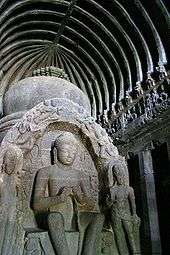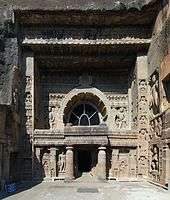Siyot caves
| Siyot caves | |
|---|---|
|
Main cave from inside | |
 Location in Gujarat | |
| Location | Siyot village, Kutch district, Gujarat, India |
| Coordinates | 23°44′23.7″N 68°46′26.02″E / 23.739917°N 68.7738944°ECoordinates: 23°44′23.7″N 68°46′26.02″E / 23.739917°N 68.7738944°E |
The Siyot caves, sometimes referred to as the Kateshwar Budhhist caves, are five rock-cut caves located near Siyot village in the Lakpat Taluka of Kutch district, Gujarat, India.
The main cave has east facing sanctum, ambulatory and space divisions which suggests a Shiva temple from the first or second century.[1] The cave was used by Buddhists later which can be concluded based on the seals found herein and the traces of Brahmi inscriptions. Other caves are simple single cells which were probably the part of eighty Buddhist caves located near the mouth of Indus river as reported by Xuanzang in seventh century.[2][3][4][5][6][7][8][9][10] Local people believes that these caves were used by dacoits to hide things looted from people in past.[11]
The excavation in 1988-89, recovered clay seals engraved with Buddha images in various mudras and seals engraved with late Brahmi and Devnagari inscriptions, copper rings, Gadhaiya coins, terracotta Nandi with bell and chain, different types of earthen wares like Surahi. Based on stratigraphic evidence, it is established that the site was occupied by Buddhist before it was again occupied by Shaivaites around twelfth or thirteenth century.[12][13] The site was repaired after 2001 Gujarat earthquake.[14]
There is a primitive stepwell located nearby.[4]
References
- ↑ Susan Verma Mishra; Himanshu Prabha Ray (5 August 2016). The Archaeology of Sacred Spaces: The Temple in Western India, 2nd Century BCE–8th Century CE. Routledge. p. 74. ISBN 978-1-317-19374-6.
- ↑ Aruna Deshpande (1 November 2013). Buddhist India Rediscovered. Jaico Publishing House. p. 133. ISBN 978-81-8495-247-6.
- ↑ "Siyot Caves". Gujarat Tourism. Retrieved 1 November 2015.
- 1 2 "Siot caves, Lakhpat taluka". Megalithic Portal Gallery. 28 October 2007. Retrieved 1 November 2015.
- ↑ "Siot caves, Lakhpat taluka". The Megalithic Portal. 28 October 2007. Retrieved 1 November 2015.
- ↑ "On Modi website, a piece on Gujarat's Buddhist link". The Indian Express. 15 September 2014. Retrieved 1 November 2015.
- ↑ "Mausam to link 10 Gujarat sites to Indian Ocean world". The Times of India. 24 July 2014. Retrieved 1 November 2015.
- ↑ "Gujarat to be projected as Buddhist pilgrimage destination". The Times of India. 11 January 2010. Retrieved 1 November 2015.
- ↑ "India plans to preserve Buddhist caves". Buddhist Channel. 30 March 2011. Retrieved 1 November 2015.
- ↑ "A Virtual Tour, Gujarat Govt Preserving Rich Buddhist Heritage". India Behind The Lens (News Centre) IBTL. 20 April 2012. Retrieved 1 November 2015.
- ↑ "સિયોત ગુફા". Ha Ame Gujarati (in Gujarati). Retrieved 1 November 2015.
- ↑ Joshi, M. C. "Indian Archaeology 1988–89: A Review." New Delhi: Archaeological Survey of India (1993). - Google Scholar, accessdate: November 1, 2015
- ↑ Indian Archaeology, a Review. Archaeological Survey of India. 1993. p. 10.
- ↑ "સ્થાપત્યોની જાળવણી માટે અઢી કરોડ... પણ!". www.divyabhaskar.co.in (in Gujarati). 24 January 2011. Retrieved 1 November 2015.


